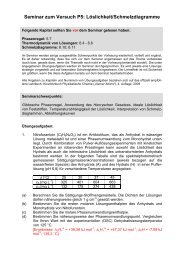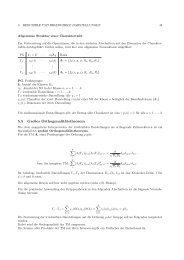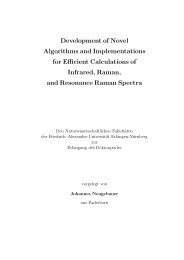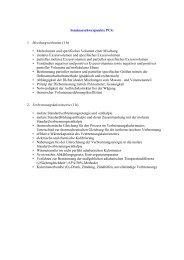Short documentation of the program (PDF)
Short documentation of the program (PDF)
Short documentation of the program (PDF)
Create successful ePaper yourself
Turn your PDF publications into a flip-book with our unique Google optimized e-Paper software.
-parfile<br />
Produce an extended parameter file (see below).<br />
-local<br />
Read a parameter file from <strong>the</strong> local working directory.<br />
-hess<br />
Perform a numerical hessian calculation using analytical first derivatives. Prints out <strong>the</strong> resulting<br />
hessian matrix in Turbomole format in gcp_hessian.<br />
-test<br />
This will stop <strong>the</strong> <strong>program</strong> before calculating <strong>the</strong> energy/gradient, but after <strong>the</strong> parameter setup.<br />
This is useful if you want to check parameters, etc. before <strong>the</strong> actual run. Additionally, a check<br />
is performed if ’steric clashes’,i.e. distances below 0.7 ˚A are existent.<br />
-v<br />
Verbose output. Currently, this prints <strong>the</strong> gradient into <strong>the</strong> standard output (stdout, console).<br />
The file gcp_gradient is not written.<br />
4.1 Using parameter files<br />
Two kinds <strong>of</strong> parameter files can be read in: A short and an extended version. Both are read from<br />
$HOME/.gcppar.$HOSTNAME by default. If <strong>the</strong> option -local is specified <strong>the</strong> file is read in from<br />
<strong>the</strong> current working directory: .gcppar<br />
The short version reads in: basis-keyword sigma eta alpha beta e.g :<br />
sv 0.2 0.4 0.8 0.9<br />
The extended version can be generated by calling gcp -parfile -level .<br />
The file gcp.param is printed:<br />
# comment line<br />
sigma<br />
eta<br />
alpha<br />
beta<br />
nbas emiss (for all elements)<br />
This can <strong>the</strong>n be modified and read-in in <strong>the</strong> usual way. Note that # is a keyword used to identify<br />
<strong>the</strong> extended version <strong>of</strong> <strong>the</strong> parameter file. Therefore, one must not delete it.<br />
5 Example calls<br />
gcp coord -level hf/minis<br />
This will do a gCP correction for a HF/MINIS calculation using <strong>the</strong> coordinates from <strong>the</strong> file<br />
coord.<br />
gcp water.xyz -level dft/631gd -grad -noprint<br />
This can be used to calculate <strong>the</strong> gCP correction for a B3-LYP/6-31G* calculation, using coordinates<br />
from <strong>the</strong> file water. It will also calculate <strong>the</strong> gradient, and add it to <strong>the</strong> file gradient (a<br />
Turbomole file), if existent. O<strong>the</strong>rwise, <strong>the</strong> gradient will be written to gcp_gradient.<br />
4







